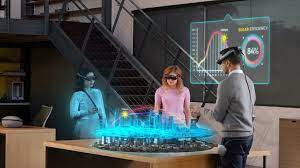Introduction
In recent years, the concept of the metaverse has gained significant traction and attention in the world of technology. The metaverse, a term coined by Neal Stephenson in his 1992 science fiction novel “Snow Crash,” describes a virtual reality space where people can interact with each other and digital environments in a seamless and immersive way. While the concept has been around for decades, recent advancements in technology have brought us closer to realizing the metaverse’s potential.
This article delves into the metaverse, exploring what it is, its historical roots, the technologies that are driving its development, and the potential impact it could have on our lives. From gaming and social interaction to education and commerce, the metaverse has the potential to reshape the way we connect and interact in both virtual and real worlds.
Understanding the Metaverse
The metaverse is often described as a collective virtual shared space, merging elements of virtual reality, augmented reality, and the internet. In this digital realm, individuals can navigate, communicate, and interact with others, as well as digital objects and environments. The metaverse goes beyond isolated virtual experiences; it aims to create a connected and persistent digital universe where people can work, play, socialize, and create in ways that were previously unimaginable.
Historical Roots
The idea of a metaverse has its roots in science fiction, with Neal Stephenson’s “Snow Crash” and Vernor Vinge’s “True Names” being early examples of this concept. These works envisioned a future where individuals would adopt digital avatars and interact within virtual spaces. Over the years, this concept has inspired many in the technology and entertainment industries.
In the 1990s, virtual worlds like Second Life and online games like World of Warcraft introduced millions of people to the idea of immersive digital environments. However, these early forays into virtual worlds were limited in scope and lacked the true interconnectedness and seamlessness that the modern metaverse promises.
Technological Advancements
Several technological advancements are contributing to the development of the metaverse:
Virtual Reality (VR): VR headsets have become more accessible and affordable, offering increasingly realistic and immersive experiences. Companies like Oculus (now owned by Meta Platforms, Inc.) have played a significant role in popularizing VR technology.

Augmented Reality (AR): AR technology, which overlays digital information onto the real world, has gained prominence through products like Google Glass, Microsoft’s HoloLens, and mobile AR apps.

5G Networks: The rollout of 5G networks provides low latency and high-speed data connections, essential for real-time communication and interaction in the metaverse.

Blockchain and NFTs: Blockchain technology and non-fungible tokens (NFTs) are enabling digital ownership and provenance, which can be vital in the metaverse for assets like digital real estate and virtual items.

Artificial Intelligence (AI): AI can create more realistic avatars, enhance virtual environments, and improve natural language processing, making interactions within the metaverse feel more lifelike.

Metaverse Platforms: Companies like Meta Platforms, Inc. (formerly Facebook), Roblox, and Fortnite’s parent company Epic Games are investing heavily in developing metaverse platforms and ecosystems.
Applications of the Metaverse
The metaverse holds the potential to disrupt and transform various industries. Here are some key areas where the metaverse could make a significant impact:
- Gaming and Entertainment: The gaming industry is at the forefront of metaverse development, with virtual worlds becoming increasingly complex and interconnected. Gamers can expect more immersive and interconnected experiences, with virtual economies and social interactions becoming central to gameplay.
- Social Interaction: The metaverse could redefine how people socialize, with virtual gatherings, events, and even workplaces becoming commonplace. Individuals may use avatars to meet friends, attend concerts, or collaborate on projects, blurring the lines between the physical and digital worlds.
- Education: The metaverse can revolutionize education by offering immersive and interactive learning experiences. Students can explore historical events, conduct virtual science experiments, and collaborate with peers in virtual classrooms.
- Commerce: Online shopping in the metaverse could provide a more immersive and personalized experience. Virtual storefronts and showrooms may allow customers to try on virtual clothes, test virtual products, and make purchases using digital currencies.
- Real Estate and Property: Virtual real estate within the metaverse is already a booming market. People are buying digital land, homes, and commercial properties. Virtual real estate can be used for hosting events, business meetings, or just as a digital investment.
- Healthcare: Telemedicine and health monitoring could become more immersive and interactive in the metaverse, allowing doctors to consult with patients using avatars and virtual environments.
- Work and Productivity: The metaverse can transform the way we work by enabling more flexible and immersive remote work environments. Virtual offices and meeting spaces may become more commonplace.
Challenges and Concerns
While the metaverse holds great promise, there are significant challenges and concerns to address:
- Privacy and Security: As people spend more time in virtual spaces, protecting personal data and ensuring online safety will be paramount. Cybersecurity threats and digital surveillance are areas of concern.
- Digital Divide: Not everyone has equal access to technology and the metaverse, which could exacerbate existing inequalities. Bridging the digital divide will be essential to ensure equitable participation.
- Addiction and Mental Health: Spending excessive time in the metaverse could lead to addiction and negatively impact mental health. Balancing virtual and real-world interactions is essential.
- Content Moderation: Policing content and interactions in the metaverse, including combating hate speech and harassment, is a challenge. Companies must develop effective moderation tools and policies.
- Monopolies and Ownership: As a few major companies invest heavily in the metaverse, concerns about monopolistic practices and control over virtual worlds have arisen. Issues related to digital property rights and NFT ownership also need to be addressed.
Conclusion
The metaverse is on the horizon, and it has the potential to reshape how we interact, work, play, and learn in both virtual and real worlds. As technology continues to advance, we must grapple with the challenges and opportunities that the metaverse presents. Ensuring privacy, accessibility, and equitable participation while addressing concerns related to addiction, mental health, and content moderation are vital as we move toward a more interconnected digital future.
The development of the metaverse is a collaborative effort that involves governments, businesses, and individuals. As the metaverse becomes an integral part of our lives, we must navigate these challenges while harnessing the transformative power of this emerging digital frontier. The metaverse offers a new realm of possibilities, and its full potential will be shaped by the choices we make today.










